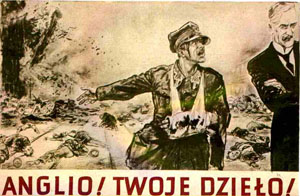2. German propaganda poster "England, see what you've done"
Questions
Description and Analysis
- In years 1937 - 1939 Great Britain pursued a policy of appeasement towards the Third Reich. This policy was based on a series of political, military and territorial concessions, each of which was to meet and prevent further demands of the Third Reich leader, Adolf Hitler, and above all to prevent the outbreak of war. These tactics were designed to pre-serve peace in Europe at any price, and to create a counterbalance against the designs of the Stalinist Soviet Union on Western Europe. Another explanation for his policy could be an attempt to postpone the war between Great Britain and Germany due to lack of prepa-ration of Great Britain for such conflict.
- Britain's Prime Minister attempted to prevent an alliance between Poland and German. Therefore, on 31st March 1939 he granted in the parliament the independence of Poland. The Polish-British Common Defence Pact was signed on 25th August 1939. After Poland was invaded by German troops, the British government issued an ultimatum on 2nd Sep-tember demanding the cessation of German aggression, and when it was rejected on 3rd September 1939, it declared war on the Third Reich.
Geographical/Historical Context
The beginning of appeasement was marked by lack of reaction of world powers to remilitari-zation of the Rhineland in 1936. The Occupation (Anschluss) of Austria on 12th March, 1938 by the German army was not condemned by France and Britain; what is more, there was no official reaction to it at all. The event which made appeasement came to light fully was the German-Czechoslovak conflict about the Sudetenland country. Sudetenland, inhabited mostly by Germans, became part of Czechoslovakia after World War I. The nations coexisted peace-fully until the mid-thirties, when a fascist party of Sudeten Germans (Sudetendeutsche Partei) was established under the leadership of Konrad Henlein. He demanded that these areas were transfered to the Reich, accusing the government in Prague of persecution, and asked the Führer for support. The Western powers joined in the German-Czechoslovak conflict. It seemed they supported Czechoslovakia, however, at the height of conflict they urged the gov-ernment in Prague to concede. The case ended at the Munich Conference (29-30 September 1938) where representatives of Germany, Great Britain, France and Italy were present, deciding about Sudetenland becoming part of the Reich. Czech MPs were not admitted into the meeting room. This could only confirm Adolf Hitler in his belief that Britain would remain neutral regardless of his activity in Europe. After Munich, A. N. Chamberlain contin-ued with the policy of appeasement. In February 1939, he sanctioned the dictatorship of Fran-cisco Franco in Spain. Britain's Prime Minister also did not react to Hitler's violation of the Munich Agreement when the Wehrmacht entered Prague on 15th March 1939.
Links
http://www.plakaty.poszukiwania.pl/thumbnails.php?album=6&page=10





Presentation
A poster features a Polish soldier, injured during defensive war of 1939, lost by Poland, show-ing in an eloquent gesture to the Prime Minister of Great Britain, Arthur Neville Chamberlain, piles of corpses and burning buildings in Warsaw. “England, see what you've done”- shouted the Polish soldier to A. N. Chamberlain. The poster was meant as a threat to the Poles who refused to cooperate with the Third Reich. With this poster, the Germans wanted to demonstrate that Britain had failed to fulfill its obligations towards the Polish allies. Such posters were put up by Germans in occupied Polish cities and towns. The poster also existed in French "C'est l'Anglais qui nous a fait ca!" The author of the French version (and probably also the Polish one) was Theo Matejko (1893-1946), one of the leading propagandists in the service of the Third Reich.